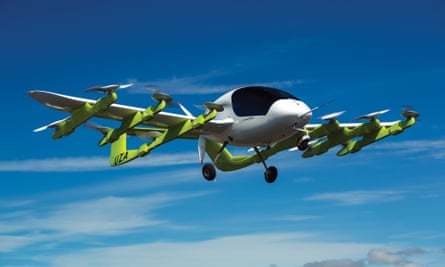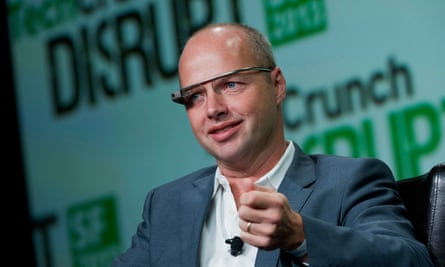Sebastian Thrun isn’t your ordinary Silicon Valley computer geek-cum-Stanford professor. The 51-year-old artificial intelligence and robotics scientist is responsible for co-developing Google Street View, pioneering self-driving cars, founding Google X – the internet giant’s secretive research lab – and revolutionising education by kickstarting massive open online courses (Moocs). His most recent project is developing flying cars.
You launched your flying car company, Kitty Hawk, in 2015 backed by Google co-founder Larry Page and you have two projects in development – a personal aircraft called Flyer and an autonomous air taxi called Cora. Why do we need flying cars?
The ground is getting more and more congested – we are all stuck in traffic all the time. Bringing transportation into the air will make things faster, safer and more economically and environmentally friendly. Just imagine travelling at 80 miles an hour in a straight line at any time of day without ever having to stop. If you’re in Jersey City in the morning and wish to go to Times Square, Manhattan, that might take you more than an hour in traffic. With an electric flying vehicle you could do it in less than two minutes on perhaps 10 cents of energy costs. It would be transformational to almost every person I know.
So the technology is there?
I believe so. Cora and Flyer are both prototypes that have shown that it is possible to take people in the air for about 20 minutes at a time with the range of maybe 50 or so miles [Cora is being tested on New Zealand’s South Island]. That is sufficient in my opinion for most of our daily trips to and from work, school, the supermarket and so on. It’s a matter now of finishing up and bringing them to market. I think in the next three to five years we’ll see a lot of change.

What about safety. Would you put one of your family members in one of these flying cars?
I’ve flown Flyer, my partner has flown it and my son who is 10 has not yet flown it but he wants to. Obviously safety is our No 1 concern and we’ve been working closely with regulators. At this point, Flyer is only operated 10ft above a water surface to make sure that, in the absolute worst case, a person can take a water landing. But as this technology matures, it ought to be safer than even existing small aircraft. That’s because the propulsion system uses many different independent motors and propellers: if you lose one it’s not a big deal.
Skies jammed with personal aircraft will probably irk a lot of people. And isn’t it a recipe for chaos?
I would concur that societal acceptance is perhaps the biggest unknown for us. We are very sensitive to factors such as noise. People worry about air congestion, and so do I, but in the air, unlike on the ground, vehicles can fly at different altitudes. You can always fly a little higher or a little lower to avoid congestion. Nonetheless, there is an important challenge to build an air management system that can accommodate maybe tens of thousands of vehicles at a time.
Won’t these things just end up being only for the rich?
Part of our dream at Kitty Hawk is to build a taxi system which could democratise this technology from day one so everybody gets to use it. We believe that the costs of the air taxi system would be even less than the cost of an Uber or a Lyft.
You won a 2005 grand challenge from the Pentagon’s research agency, Darpa, to create a driverless vehicle. That led you to found Google’s self-driving car team, now a company called Waymo. What’s your assessment of how the field is progressing?
I am an impatient person by nature. I would love self-driving cars to take over the world right now. If you take a ride specifically in a Waymo car today, the technology is basically ready. The regulators have been amazingly cooperative in embracing this new vision. The real challenge is to have customers adopt it. We are in the very early phase with that.
In March this year a woman pushing a bicycle across the road was struck and killed by a self-driving Uber vehicle in Phoenix, Arizona, causing Uber to suspend testing in the city. How much of a setback has the death been for autonomous vehicles, generally? Is it inevitable that people will die as this new technology matures?
The Waymo team has now successfully driven over 5m miles. In all those miles, a software glitch caused exactly one minor collision. Almost all traffic accidents are the result of lack of attention and distraction. The Waymo car never texts, it never sleeps, it is never drunk, it never fails to pay attention and it even looks in all directions all the time. As a result, it ought to be that we can eventually cut the number of traffic deaths by a factor of 10 or more, and even possibly down to zero.
You’re a keen cyclist. How worried are you about the impact of autonomous vehicles on cycling? Are the systems sophisticated enough to monitor and respond to unpredictable behaviour?
When I ran the Google team we very actively worked on predicting the behaviour of and interacting with bicyclists, small children, deer and other seemingly unpredictable elements of real traffic. A self-driving car has enormous precision. It sees even the smallest amount of motion. As a cyclist who has been exposed to danger many times by trucks passing at less than an inch clearance, I can’t wait for cycling among self-driving cars because it will be safer than it has ever been.
You’ve worked on applying AI to healthcare. What will it do for us?
We found that a well-trained neural network combined with a smartphone is as accurate as the best human experts at detecting skin cancer. That makes it possible to take the expertise of the best doctors and put it into the hands of everybody. It’s still early. But I have this dream that if we just rethought diagnostics as something that happens every day for every person at home we might be able to diagnose all sorts of diseases that are life-threatening before it is too late.
In 2011, you co-founded the online technology education firm, Udacity, to offer Moocs after the success of a Stanford AI course you ran online. Later you left Google to focus on it. Initially there was exuberance with Moocs then disillusionment, with the New York Times declaring in 2013 that Udacity was a flop. Where do things stand today?
I don’t think Udacity has been a flop at all. It is just that it takes probably a decade or more to get to the point where we can really move the needle on educating a large number of people. Since 2011, we have really learned how to make the medium successful. We learned that students love community and one-on-one mentorship. Back in the day, our finishing rates were typically 3-5%. Today, our finishing rates have been as high as 60-70% in some of our nanodegree programmes [which charge participants a fee of typically about $1,000]. Globally around 10 million people have registered and in any given month we have roughly 50,000 paying students signed up for a nanodegree. We would be profitable but we reinvest our fees back into innovation. And people are being hired out of these courses. We are the biggest supplier of talent in hot topics like self-driving cars and deep learning. We teach more students self-driving car technology than all the universities in the world combined.
Is there a sci-fi book or film you’ve raided for ideas?
To get ideas I just look at what bothers me. Why am I stuck in traffic every day? Why did my sister die of breast cancer if it can easily be diagnosed? All these problems have solutions. There’s a lot of opportunity for innovation in so many aspects of everyday life.

You are one of the experts interviewed in the documentary Do You Trust This Computer? which has just been released in the US
and warns about the potential dangers of artificial intelligence. What scares you?
My biggest fear is that people rush to premature judgment. New technologies have always been scary. A hundred years ago people feared high-voltage electricity in their homes. Today we have become dependent on it. What we need is an open and broad conversation on how to best leverage this new technology. I believe this is taking place today.
When it comes to making the world a better place, is Silicon Valley delivering?
Yes. Not everything is perfect, but consider the value added to society through the advent of smartphones, social networks, and free online education through Udacity. Udacity teaches many millions of students in the world. It makes high-quality education accessible everywhere. And self-driving cars might at some point save more than a million lives every year. These are big things.
From policing to access to finance, AI is being increasingly used to make decisions that can change people’s lives. Groups like the American Civil Liberties Union say there is a danger that the gender and racial biases we have already will get woven in. How do we do better?
We should pay attention to this and understand whether the machines we train are inappropriately biased or lead to bad decisions. I am a big fan of people and machines working together in decision making, with people having the ultimate authority to make life-changing decisions. I am much less a fan of leaving such decisions to machines, no matter how good AI has become.
Google Glass emerged out of Google X but was then discontinued in 2015. Where did it go wrong? Are you sad that Google’s face computer didn’t get off the ground?
We launched Google Glass too early – before we had figured out the exact use case and built a functioning user interface. While I’m sad that Google Glass wasn’t a smashing success in its first situation, I am optimistic about what’s happening today. Google Glass is alive again, this time more focused on workplace use. Doctors are using it in patient care and it’s even being used in agriculture. I am confident it will come back.
You were working on a project to revolutionise home cooking. How is that going?
This was just a hobby and it’s cancelled. We invented a method in which you could make a freshly cooked perfect dinner in less than three and a half minutes. We filed a few patents, we ate a lot of food. But at the same time, running Udacity and Kitty Hawk was enough of a workload for me. As an entrepreneur you play with a thousand ideas, you elaborate a hundred, you like 10 and then you finally do one.
What’s your holy grail of inventions?
I would love to directly interface my brain to all the computers in the world, so I could be truly superhuman. I would know everything – every name, every phone number, every fact – and I would be born speaking every language and with the full wisdom of my parents and forebears.

Comments (…)
Sign in or create your Guardian account to join the discussion